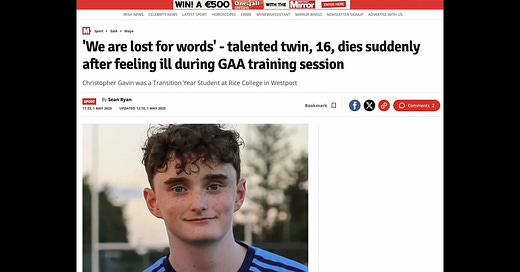It’s been more than 21 years since the sudden death of Tyrone football captain, Cormac McAnallen. The 24-year-old GAA star went to bed and never woke up. His unexpected death on the morning of March 2, 2004 garnered widespread publicity in the mainstream media. It was a big deal. The public was in shock. Back then we weren’t used to young people just dying for no apparent reason.
Cormac McAnallen’s mother Bridget told the Irish Independent:
“At that stage we weren’t aware that a young person who was very fit and healthy could die from a heart condition. Maybe with a 60-year-old there’s a possibility. At his age, definitely not.”
Priming
Cormac McAnallen’s death signalled the beginning of changes in the GAA. The association sent out questionnaires to its players as part of a screening programme to detect underlying heart issues. Clubs started to set up defibrillators in case of emergency. The association began to collect vital data that could inform us about the situation today where sudden death in players has become the norm, as the video (above) attests. There’s barely any inquiry into how these young people died and there’s no wall-to-wall news coverage like that afforded to the death of Cormac McAnallen. The newspaper articles just say the young player ‘died suddenly’. That’s it. The reader is left guessing as to the possible cause. This is done on purpose to create confusion and to deter further inquiry.
Risky Medical Trial
The GAA has questions to answer, especially since it coerced its players into a dangerous medical trial for no reason during the Covid scam, while the association’s top dogs profited from pushing the unnecessary injections on their members. So far there’s been zero accountability for the excess deaths, just platitudes and empty condolences to the families of the deceased.
This is an example of how the GAA pressurised its young people into the risky medical trial linked to sudden death, heart issues, blood clots and cancers, to name but a few. Notice how those who promoted the injections never mentioned side effects or the fact that young people were at no risk from the mystery virus that had somehow replaced the flu. There was no pandemic, no excess deaths in 2020, after all the hysteria.
From Rare to Normal
Let’s cut to 2006 to get an idea of the landscape regarding heart issues in Ireland at the time to give us some context. A report commissioned by the Department of Health said around 5,000 Irish people died from sudden cardiac death every year.
Eilish O’Reagan of the Irish Independent reported:
The majority will be over the age of 40 and it will be as a result of cardiac disease, but a small number younger than this age will also fall victim.
Although there is not enough evidence to justify a mass population screening programme, the immediate families of sufferers who are aged below 40 need to be assessed.
As sudden deaths in our young people become normalised in the mainstream media and the Internet is ‘tidied up’ to suit the new narrative, it’s important to take note of this excerpt from November 30, 2006 and to remind ourselves of how rare it used to be for healthy young people to die unexpectedly. To reiterate, in 2006 there was not enough evidence to justify a mass population screening programme. Something drastic has changed since then and nobody wants to talk about it for some reason. Our young people are dying in unprecedented numbers since the rollout of the trial Covid-19 injections and nobody’s reacting appropriately. We’re supposed to pay our respects and move on. Not good enough.
Where’s all this data that the GAA has collected from its questionnaires about the health of its players? Why has it been kept from the public? Why aren’t the families of the deceased demanding answers for their loved ones? This is not normal.
An Irish Times report from January 31, 2007 stated there was an average of five sudden cardiac deaths in Irish sport each year in the 14-35 age group bracket. Why don’t we know the figures for 2021, 2022, 2023 or 2024 so we can compare and contrast with pre-mass ‘vaccination’ sudden cardiac deaths? The numbers are being kept from us deliberately, because the GAA is hiding the extent of the problem and gaslighting those of us who bring it up as if we’re mad to recognise the increased rate of sudden deaths in young players.
Who benefitted? How much?
We also need to know how much money the GAA made during the Covid hoax from various health authorities. How much was its management paid to ensure Ireland’s fittest and healthiest athletes risked their lives for a fake pandemic? Too many GAA members have died since the rollout of the dangerous injections and the guilty parties want us not to notice. They’re gaslighting us. We must demand answers. No more herd mentality. Silence is complicity at this late stage. Our young people deserve better than cowardice. We must show courage for those whose lives have been stolen. Here’s a reminder of mainstream media coverage throughout the phoney pandemic and shows us the pressure these young players were put under by the GAA to enter the liability free medical trial with no short term or long term assurances.
The Final Whistle
The charity set up in memory of Cormac McAnallen by his family blew its final whistle in 2024, ceasing activity on the 20th anniversary of the Tyrone football star’s sudden death.
The Cormac Trust had completed its mission: to raise awareness of Sudden Arrhythmic Death Syndrome (SADS). The charity spent £200,000 in donating more than 300 defibrillators to sports clubs, community groups, schools and emergency services.
A lot has changed in those two decades. Sudden death in athletes has become normalised. All that screening couldn’t prevent the deaths of the young GAA players we see dying in alarming numbers, without proper investigation or coverage in the mainstream media. The defibrillators have failed to keep the numbers down. In 2007, the average number of sudden cardiac deaths (14-35 years) in Irish sport was FIVE per year. What is it now? The GAA won’t release the updated figures. We’re kept guessing.
Who’s counting?
Show your support independent journalism and buy Aisling a coffee HERE. Thank you.














Share this post